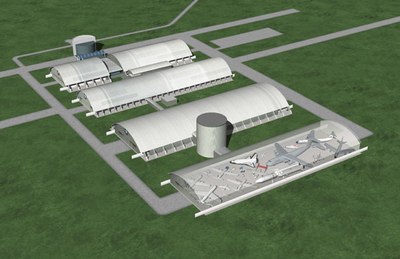A tale of two museumsby Jeff Foust
|
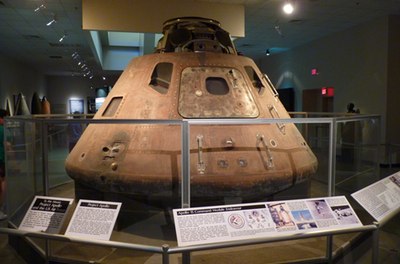 The Apollo 15 capsule greets visitors at the entrance to the Missile and Space Galeery at the Air Force Museum. (credit: J. Foust) |
It’s easy to see in some respects why the museum would be considered a frontrunner for a shuttle: it is an impressive facility. Located adjacent to Wright-Patterson Air Force Base, the museum occupies three large hangars that tell the story of the US Air Force and its predecessor services with dozens of aircraft, from World War I-vintage airplanes to the F-22, with plenty in between from World War II, Korea, Vietnam, and more. It’s easy to see why the museum is very popular, with a nearly-full parking lot on a recent Saturday (the fact that there’s no admission fee certainly helps.)
At the end of the third hangar, at the far end of the museum from the entrance, is a silo-like structure called the Missile and Space Gallery where the museum’s space-related artifacts are displayed. The emphasis is as much (or more) on missiles and space, but the exhibit does include the Apollo 15 command module (which flew an all-Air Force crew on its 1971 mission), flight-rated by never-flown Mercury and Gemini capsules, various rocket engines, and assorted other items, with the missiles—including a Titan 2, Minuteman 3, and Peacekeeper—on vertical display. One curiosity on that visit was a large satellite (or at least replica of one) that had apparently been added so recently it was still sitting on a cart in the exhibit area; the satellite looked like a DSP missile early warning model, but there was no text identifying or describing the satellite.
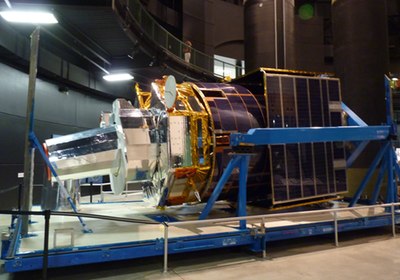 An unlabeled satellite, which at least looks similar to a DSP satellite, was sitting on the floor of the Missile and Space Gallery. (credit: J. Foust) |
To host a shuttle, though, the museum would expand. The museum proposes to build a fourth hangar that would house the shuttle, as well as some other space artifacts, such as a Titan 4 rocket recently acquired by the museum. The Space Gallery would share the hangar with some other aircraft, such as presidential aircraft currently housed in a hangar at Wright-Patterson. While the museum is competing with others from Seattle to New York, as well as JSC and KSC (see “An Intrepid quest for a shuttle in New York”, The Space Review, June 28, 2010), its current facilities and proposed new ones for the shuttle would seem to put it at the forefront of the competition.
The other end—or close to it—in space museums is just 100 kilometers to the north of Dayton. There, just off an exit of I-75 in the small town of Wapakoneta, Ohio, is the Neil Armstrong Air and Space Museum. Unlike the Air Force Museum, it is not vying for a shuttle orbiter. In fact, it seems like it’s barely hanging in there.
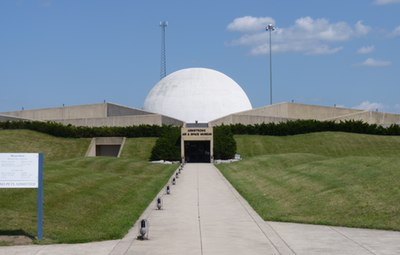 The entrance to the Neil Armstrong Air and Space Museum in Wapakoneta, Ohio. (credit: J. Foust) |
The Neil Armstrong museum has few of the advantages of its larger counterpart an hour’s drive south. It is a small facility, looking as much like a bunker as anything (although a bunker with a white dome on top), making it difficult to stand out in a terrain of gas stations, big box stores, and fast food restaurants. (To get there, though, you do drive through arguably one of the coolest intersections around for space enthusiasts: the corner of Apollo Drive and Saturn Drive.) It’s not surprising, then, that on a recent visit in the middle of a Friday afternoon the parking lot was nearly empty, so much so that it left one to wonder if the museum was in fact open. (It was.)
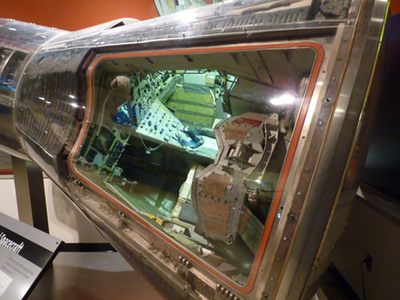 the Gemini 8 capsule is perhaps the highlight of the Armstrong museum. (credit: J. Foust) |
Once you pay the admission fee—$8 for adults, $4 for children ages 6–12—you’ll find there’s not that much to see. The highlight of the museum is the Gemini 8 capsule on display, which Armstrong flew on his first space flight with Dave Scott, barely escaping with their lives when a thruster on the spacecraft stuck on, causing a severe roll. Beyond that, the museum’s exhibits try to tell both the story of the Space Race between the US and USSR as well as the life of Armstrong, but at a fairly basic level. The white dome houses a small auditorium where they screen a film every half-hour, but it is a generic video about the Apollo 11 mission that will be of little interest to anyone with at least a cursory knowledge of the mission. Surprisingly, despite visiting the day after Armstrong’s 80th birthday, there was nothing readily visible in the museum marking that milestone.
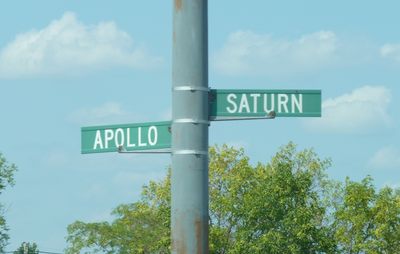 One advantage the Armstrong museum has over the Air Force museum: this intersection. (credit: J. Foust) |
Given that, there’s little there to draw someone to a relatively out-of-the-way location (unless you happen to be driving by on I-75, which is a major north-south interstate highway) except for those hard-core space aficionados who want to visit every space-related museum or see every capsule from the early Space Age. That certainly poses a concern for the museum’s long-term prospects as the Apollo era fades further into the distance and out of the memories of a growing fraction of the public. While the Air Force Museum battles to secure a piece of more recent space history, the Neil Armstrong Air and Space Museum may be battling to stay relevant.
